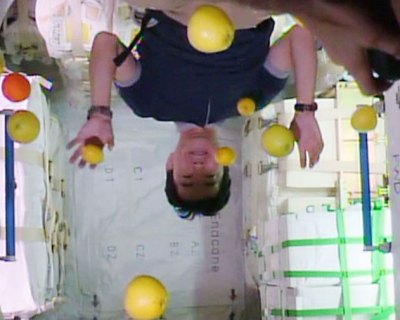
While unloading Japan's supply ship, astronaut Kimiya Yui poses upside down with fresh fruit. Image: NASA.
On a regular basis, NASA posts photos and videos of slap-happy astronauts doing air somersaults around the International Space Station. The most recent example occurred this week, when an astronaut was photographed upside down, surrounded by floating fruit.
That’s microgravity. Back on Earth, we can’t do that. Our movement is restricted by gravity, defined by The American Heritage Dictionary (Houghton Mifflin Company; 2006) as the “natural force of attraction exerted by a celestial body, such as Earth, upon objects at or near the service, tending to draw them toward the center of the body.”
Microgravity is a condition in which there is little net gravitational force. Here is a brief explanation, along with sources and links that will offer a broader understanding.
First, microgravity isn’t the same as no gravity. The space station is actually kept in orbit by gravity, NASA explains.
The near weightlessness that astronauts experience in microgravity is “induced by free fall or unpowered space flight,” according to the Science Dictionary.org. (Freefall is defined simply as the “motion of an unpropelled body in a gravitational field.” In other words, it is what happens when a body or object is pulled toward Earth by gravity.)
All that floating around looks like fun, but it has a serious downside. Without gravity's effects, “blood and other body fluids begin to flow toward the head. This can cause a feeling of stuffiness and headaches,” the European Space Agency explains. And astronauts at the space station must exercise constantly so that muscles and bones don’t weaken.
Thanks to microgravity, astronauts appear to be light as a feather in space. They aren't that way on Earth, of course. Weight is a measure of heaviness, but it also is a measure of the pull of gravity on an object, according to the New York University article, Mass versus Weight.
By dictionary definition, mass is “a unified body of matter with no specific shape.” NASA defines mass as “the amount of matter in an object.”
The New York University article makes an important distinction. Unlike weight, the mass of an object “doesn't change when an object's location changes.”
Sources:
- European Space Agency: Gravity and Weightlessness.
- NASA: What is microgravity?
- New York University: Mass versus Weight.
- The American Heritage Dictionary (Houghton Mifflin Company; 2006).
- The Science Dictionary.org: Free Fall.
- The Science Dictionary.org:Microgravity
If you would like to comment, like us on Facebook and tell us what you think.